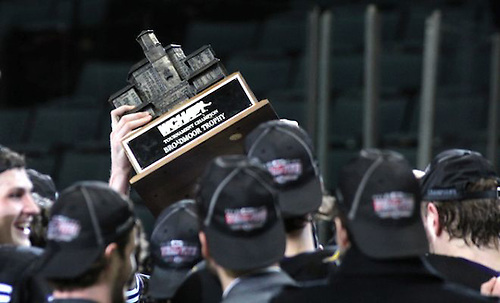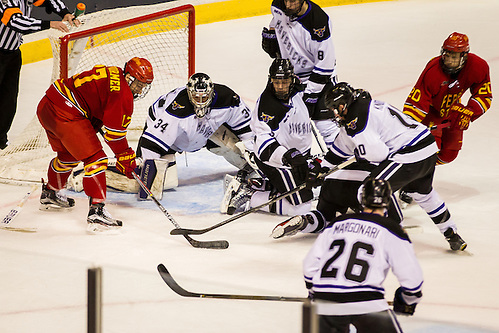
In the case of the WCHA, you really can go home again.
Literally.
Last week, the conference announced that all playoff games next season will be contested on campus sites, with the highest seed playing host in each round.
The playoff championship game will now be known as the “WCHA Championship.” The “Final Five” is no more.
The 2017 WCHA Playoffs will consist of four best-of-three, quarterfinal series hosted by the league’s top four regular season finishers on the first weekend of March. Two best-of-three semifinal series will follow, hosted by the highest remaining seeds on the second weekend of the month.
Then the WCHA Championship will be a single game, hosted by the highest remaining seed, on the third Saturday of March (the same weekend as the “Final Five” of previous seasons). As has been the case since the 2013-14 campaign, the top eight teams from the WCHA regular season will qualify for the postseason.
According to WCHA commissioner Bill Robertson, changing the format will change the fan experience for the better and will save on travel costs, in addition to increasing PairWise Rankings and league revenue.
Robertson said breaking the agreement with the Xcel Energy Center in St. Paul, Minn., where the Final Five was to be held in 2017, was a fluid transaction.
“We give a lot of credit to the owner of the Minnesota Wild, Craig Leipold, chief operating officer Matt Majka and the general manager of the Xcel Energy Center, Jack Larson, for understanding what we wanted to do going forward with our league,” said Robertson. “They were happy to assist in that process. I can’t disclose any financial information, but I would say that we made a healthy break with them and they were supportive of our decision. It just helps them better understand the Wild schedule during the month of March.”
The timing of the move left some questions. Why now? Why not play out the remaining year on the contract with the Xcel Energy Center and look at making the change for the 2018 postseason?
Robertson wouldn’t say exactly that low attendance figures played a role. The 2016 Final Five at Van Andel Arena in Grand Rapids, Mich., drew just a shade over 4,000 for the championship game that Ferris State won over Minnesota State.
Van Andel Arena has a seating capacity of nearly 11,000 and is the home of the AHL’s Grand Rapids Griffins.

“I think more than anything, we felt that we wanted an atmosphere where the fans would be excited,” Robertson said. “When you’re on campus, you have a better chance for fans to see this up close and personal and we thought for the student-athlete itself, the fan experience there, for them to play in front of larger crowds would be an added plus and bonus. Those are two of the best possible scenarios that you have coming out of this. All of our presidents, athletics directors and head coaches felt this was a great step for the WCHA and is really revolutionary for college hockey at the Division I level.
“We also felt this was a chance for us to make a splash and a name for the WCHA.”
The Big Ten also is preparing to move to home sites for its playoffs in 2018, the Star Tribune reported.
With campus sites being used in the WCHA, it would create a potential for Alaska or Alaska-Anchorage hosting one or more series.
That topic arose during discussions, said Robertson, who did not comment on the financial specifics or time needed to travel to Alaska.
“We did talk to both Alaska schools and all 10 schools [in the WCHA] were involved in this process in talking it through,” Robertson said. “They felt all 10 teams are equal in the WCHA and this gives us the best chance to succeed. If our Alaska schools are hosting, well, that’s a great thing. We’re competitive all the way through our 10 teams.”
Ferris State coach Bob Daniels made mention that the past two Final Fives probably had crowds that supported one team over another.
“Last season at Van Andel, we had pretty solid attendance,” said Daniels. “It was a real championship atmosphere, but the issue in time becomes … it was really like a home-rink advantage to us. (Big Rapids is just an hour north of Grand Rapids.) With us and Michigan Tech moving on, we were able to bring a lot of our fans there. [In 2015] at the Xcel Energy Center when we played Minnesota State, we had a good crowd, but that was driven by Minnesota State. That’s not a given from year to year. I think as you look long range, you can’t count on those things.”
Daniels added that there is a lot to like about the new format and insinuated that the new-look tournament will have both teams in any given series on an even keel.
“The NCAA tournament is bracketed and as a coach that has been on campus and at neutral sites, it’s a different animal,” Daniels said. “In 2002-03, and I’ll use as an example, we had to play Minnesota at Mariucci Arena. Now, that’s an Olympic sheet and was certainly 95 percent Gopher fans. We had a very good hockey team that year and the Gophers won the national title, but I will tell you to this day that our players always felt like they would have loved to play the Gophers on a neutral site. When you talk about the NCAA tournament on a neutral site, I think that’s a better avenue because it is a tournament.
“When you talk about playoffs and given the geography of our league, I think you are much better suited to have those on campus. That’s my take on comparing [the NCAA tournament to the WCHA tournament].”
And at the end of the day, the players on the ice could see the biggest benefit.
“One of the things the ADs were talking about here was decreasing travel and increasing rest for teams,” said Northern Michigan athletic director Forrest Karr, who also serves as the chair of the WCHA league management council. “If you think about our old format, on the last regular season weekend of the year, we had five teams traveling and then we went into the playoffs and had the best-of-three with four teams traveling. Then we had four teams travel to the neutral site for the final tournament, so over the course of the last three weekends of the year, we had 13 teams traveling. With the new format, you’ll have seven teams traveling. And then if you look at the maximum games that teams would play over those three weekends, it was seven in the old format and under this new format, it’s the same.
“It reduces travel and increases rest as you get toward the NCAA tournament, and that’s probably the most important thing for the last one or two weekends. That was a really big consideration among the athletic directors.”


